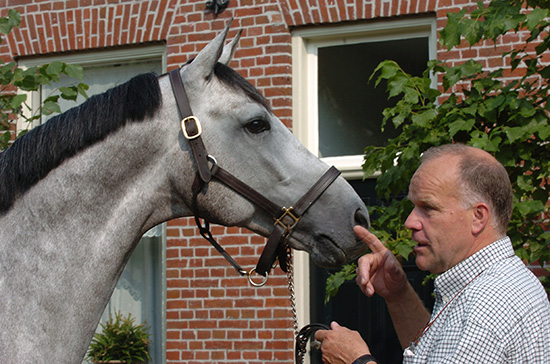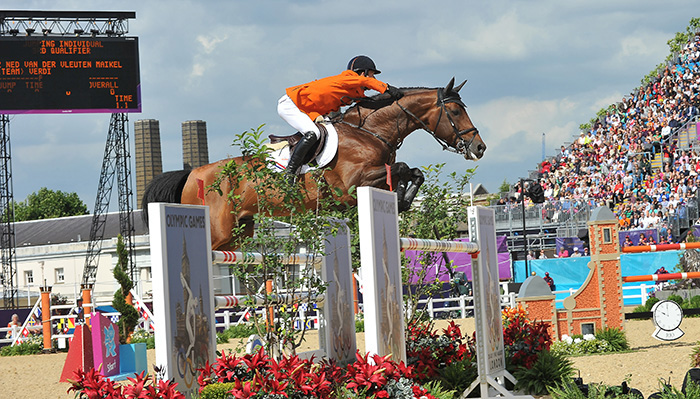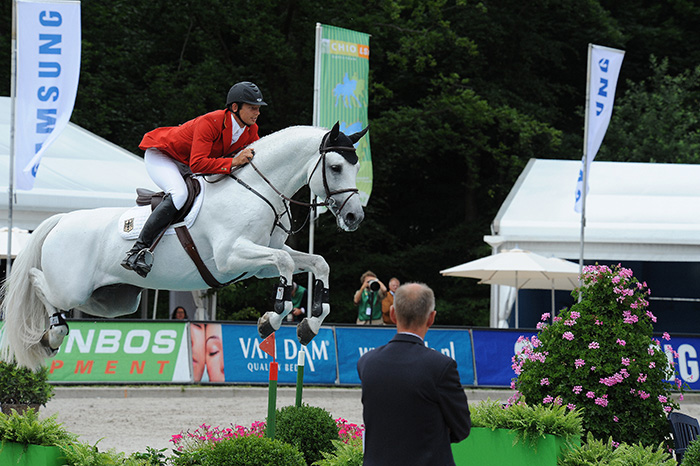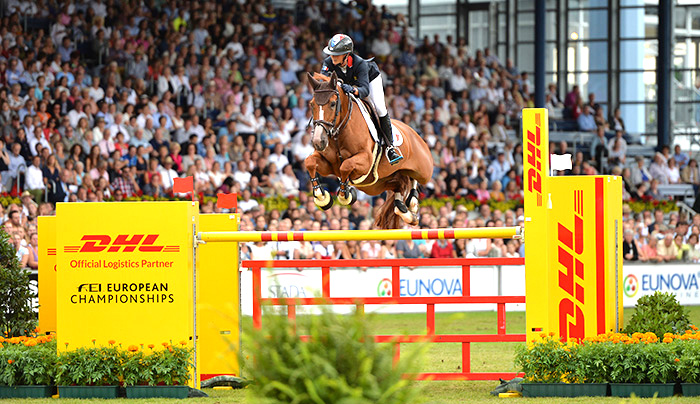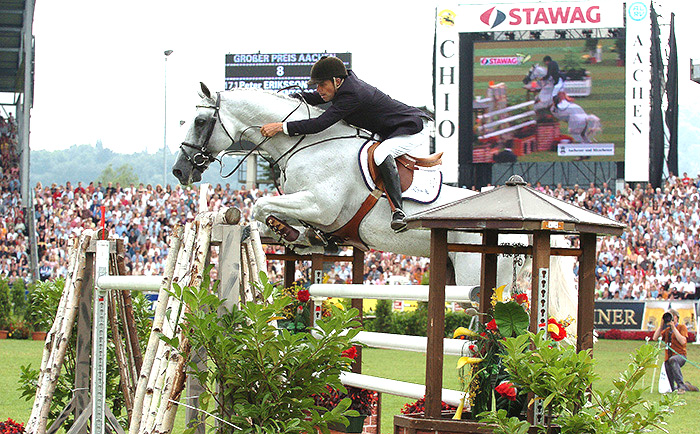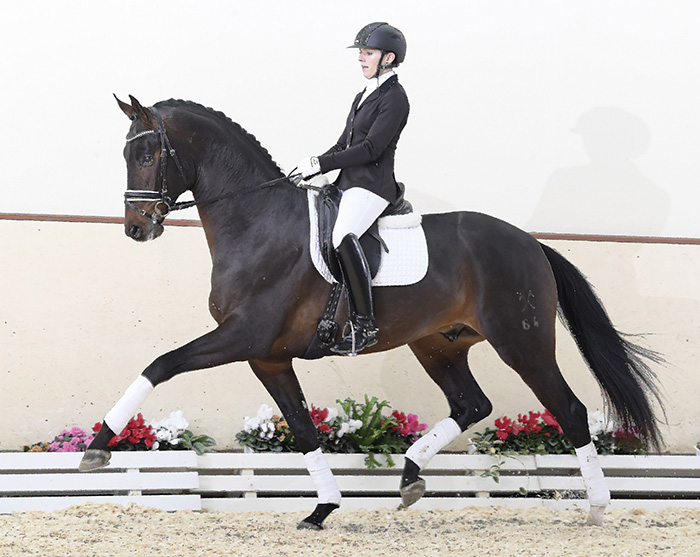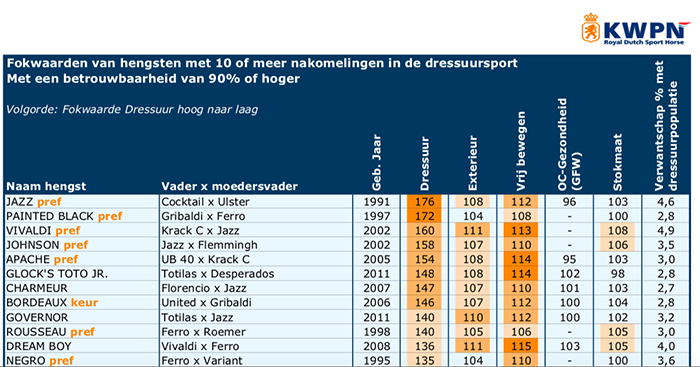
by Christopher Hector and Gemma Alexander
Once it was believed that it was the jumping fraternity that bred their horses ‘tight’, while the dressage horses tended to be a bit more random… Well right now it would seem that the reverse is the case if we look at the two top 20s – dressage and jumping – on the 2021 KWPN breeding values for stallions with a reliability of 90% or higher.
In the dressage list, in the first three generations we find Ulft twelve times. Oh yes, you say Ferro, but it is interesting that on a number of pedigrees Ulft pops up without the aid of his favorite son.
Cocktail appears nine times, and yes, that is mainly through his number one son, Jazz. Flemmingh appears eight times, and Gribaldi, five times.
Perhaps it is time to look hard at the breeding career of Ulft.
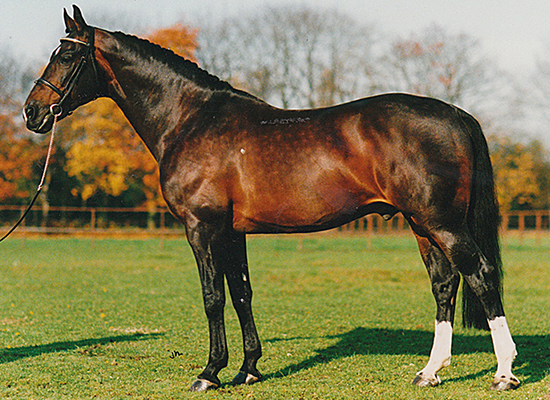
Ulft (photo Jacob Melissen)
It was in January 1981, when the three-year-old, and until then, un-named bay stallion, Ulft was baptized with the name of the village in the Guelders county.
Let the Dutch expert, Jacob Melissen take up the story:
“Ulft was a comparatively small colt, standing just 16 hands, with 8.25 inches of bone, but his movement in hand was superb. He showed an almost perfect driving action of his hindlegs – but his total appearance failed to impress the judges sufficiently for him to be ranked in the top group of colts.”
“At that time, the newly selected colts were ranked in two groups, depending on their quality. Twelve colts were placed in the first group – all of which have disappeared. The last one was the French bred, Ursus. He died in 1993, but the majority had disappeared after their performance test, or after their first four years at stud. Who remembers the names Uithof, Tigrato, Unyx, Ubbo, Umberto, Utewaal and Uitblinker, nowadays? Yet they were the ‘stars’ of that totally forgotten first quality colt group!”
“In the second quality group there were 17 young stallions, listed by the judges, of whom there are only five at stud! The former showjumper, Olympic Treffer (in Italy), Utrecht in Holland but only licensed by the British Studbook, AES, and finally – Ulft, Uniform and Triton in regular service in the KWPN (Dutch Warmblood) Studbook. As Triton had been selected in the ‘last chance’ show, and therefore not listed in any quality group at all, you may consider the ‘keur’ stallion Ulft, and his ‘preferent’ colleague, Uniform, as the last survivors from the year of the letter ‘U’.”
Thanks Jacob…
After the performance test, where he finally succeeded in taking fourth place, Ulft started his career. In 1981, he was bred to only one mare because by the time his performance test was completed, the breeding season was nearly over. In the following years, he served some 1,730 mares, an annual average of 123 coverings.
Most dressage fans remember Ulft’s most famous foal – Ferro, ridden by Coby van Baalen but Coby also rode the sire: “Ulft was the first licensed stallion I got to ride,” Coby told me. “He was then owned by Mr van Tuyl from Gameren and he put him in training with me to be shown. At that time, there were still special classes for stallions called “bestgaand rijpaard” (best performing riding horse). It was always a battle between Ulft and Uniform.”
Out of his 1,250 foals, six sons were licensed: Boston, Conveyer, Dublin, Dukaat, Fair Play and Ferro.
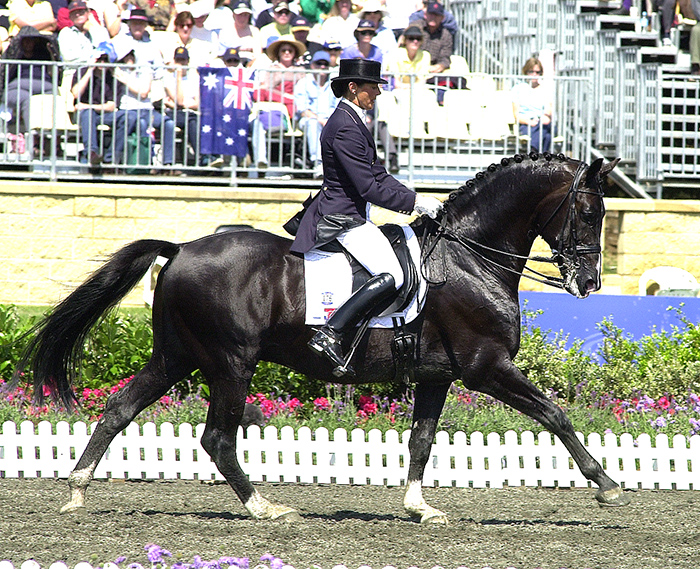
Ferro at the Sydney Games
Story continues below the advertisement
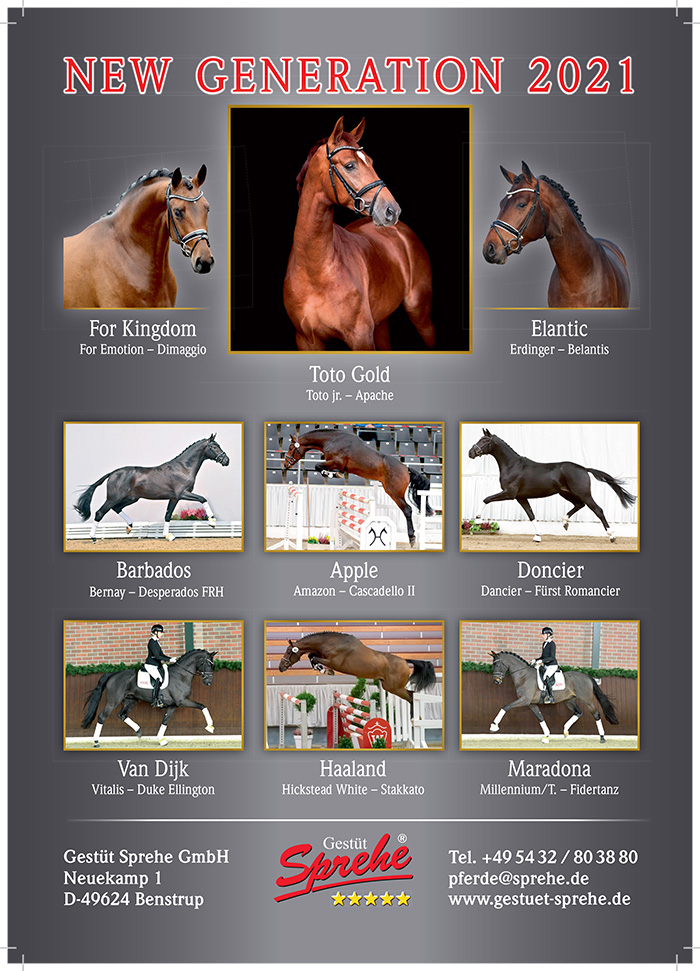
It is also notable that in the 2021 KWPN values, 12 out of top 20 are solidly Dutch bred, with five that are half German – Sandreo (Sandro Hit), Everdale (Lord Leatherdale), Toto Jr (out of a Desperados mare), Charmeur (Florencio). Bordeaux (United / Gribaldi) and Rousseau (Ferro / Roemer) are 25% German, while Chippendale (by Lord Leatherdale with Landadel on the dam line) is 5/8ths German bred.
The top 20 is headed once again by Jazz (Cocktail / Ulster) with a value of 176 – interestingly he has a negative score for OCD transmission, 96. Second to Painted Black (Gribaldi / Ferro) on 160, then Vivaldi (Krack C / Jazz) also 160, Johnson (Jazz / Flemmingh) no OCD rating for that trio, followed by Apache (UB40 / Krack C) 154 and another OCD negative, 95; Toto Jr (Totilas / Desperados) 148, and, at last, a positive OCD score, 102. Charmeur (Florencio / Jazz) 147, 101; Bordeaux (United / Gribaldi) 146, 100 (100 is neither positive or negative as an indication of the likelihood of transmitting OCD); Governor (Totilas / Jazz) 140, 100; Rousseau (Ferro / Roemer) 140 – and since he was born in 1998 before the introduction of the OCD testing, no OCD score; Dream Boy (Vivaldi / Ferro) 136, 103; Negro (Ferro / Variant) 135; United (Krack C / Partout) 135; Chippendale (Lord Leatherdale / Negro) 134, 95; Desperado (Vivaldi / Havidoff) 126, 104; Everdale (Lord Leatherdale / Negro) 126, 95; Ferdeaux (Bordeaux / Ferro) 122, 97; Obelisk (Matador / Clavicimbel) 121; Sandreo (Sandro Hit / Flemmingh) 115 and rounding out the 20, Uphill (Oscar / Apollios) 114.
The KWPN has also published breeding values for the most used recognized rather than approved stallions and the list is headed by Double Dutch (Johnson / Rubiquil) with a better dressage value than Jazz! I have no idea why this stallion is included in this group of mainly foreign sires. He was licensed by the KWPN in 2017 as a nine-year-old on the basis of his Grand Prix performances – like so many of the good stallions, he was rejected by the licensing commission at the stallion show. Double Dutch has a dressage value of 182 (perhaps that’s the reason, the KWPN couldn’t bear to knock Jazz off his number one perch) and even has a positive OCD rating 102. Curious.
My good friend Jacob Melissen set out to unravel this mystery for me, and received this reply from Ralph van Venrooy, a senior inspector of the KWPN:
Individual recognition of a stallion is only possible for exceptionally good stallions. This applies to foreign registered stallions as well as to KWPN registered stallions who have already proven themselves as a sire of Grand Prix horses or who have successfully performed at the highest level for a long time. Individually recognized stallions receive the same status as approved stallions. This means that the foals are registered in the foal book and mares can be included in the stud book from the age of three without additional requirements.
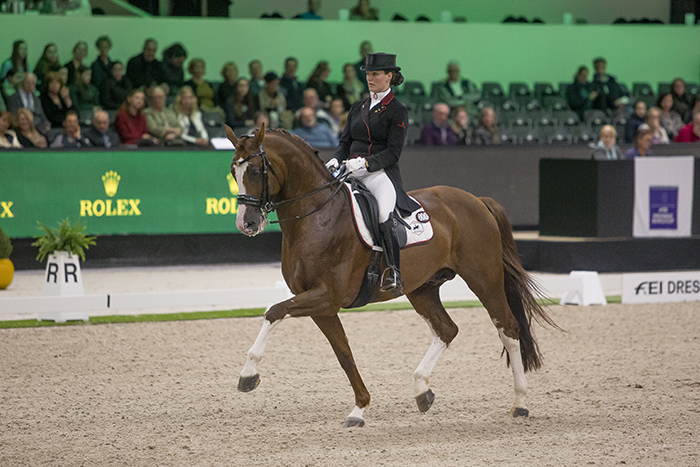
Double Dutch – photo Dirk Caremans
The stallion Double Dutch is recognized by the KWPN and not approved. For this reason he is also on the list of the KWPN recognized dressage stallions.
Thanks again Jacob and Ralph – though it does seem to me passing strange that a stallion who has actually competed Grand Prix and has the highest breeding value is only recognized not approved, while the ranks of the approved stallions include a number who have never competed at anything like Grand Prix, and whose breeding value is way lower…
Story continues below the advertisement
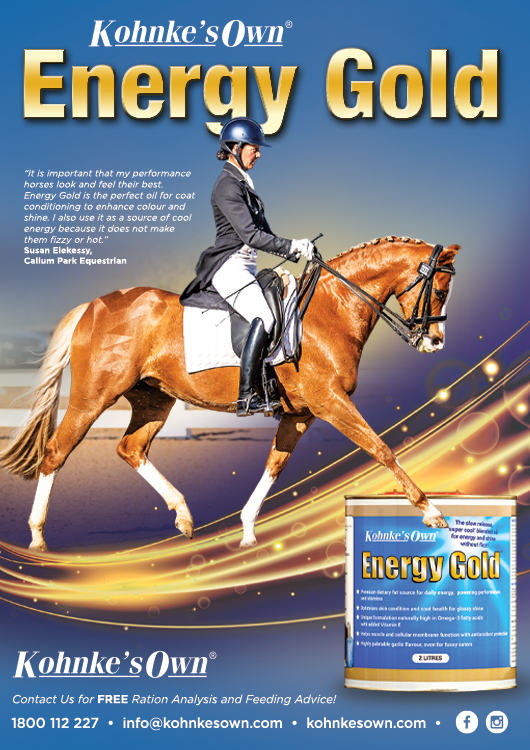
The next highest ranked is the Danish stallion, Skovens Rafael (Romanov / Don Schufro) 172, 100. Then Vitalis (Vivaldi / D-Day) 168, 99 equal with Don Olymbrio (Jazz / Ferro) 168, 98; Totilas (Gribaldi / Glendale) 156, 98. Two are tied on 149 – Zack (Rousseau / Jazz), OCD 103 and Damsey (Dressage Royal / Ritual) with a positive OCD score of 104. Zonik (Zack / Romanov) rounds out the list with 142 for dressage and an OCD value of 103.
My colleague, the statistically literate, Gemma Alexander looked at the bigger picture in her analysis of the dressage stallions, and found the first generation of foundation sires the dominating influence when you looked at six generations…
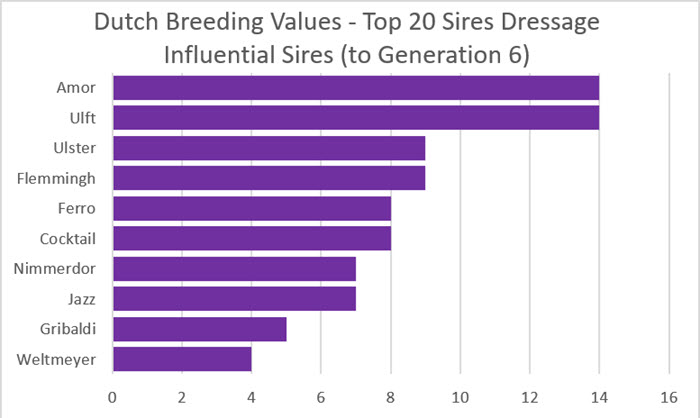
While the dressage breeding has historically been a little more random than that of the jumpers, the chart above shows that perhaps the tide is turning. All but one of the top 20 dressage stallions (>90% reliability) have at least one of the ‘influential sires’ appearing in the first six generations. The anomaly is Uphill (Oscar/Apollonious), with none of these sires in the first six generations, he is the biggest wildcard in the field.
There is a tie for the most influential sire of the dressage stallions between Amor (Herrscher /Loretto) and Ulft (Le Mexico/Pericles xx), who both appear 14 times in the first six generations of these horses. Next we have tied for third Ulster (Nimmerdor/Antonio) and Flemmingh (Lacapo/ Carneval), at nine appearances apiece, and tied for fifth are Ferro (Ulft /Farn) and Cocktail (Purioso/Le Val Blanc xx) with eight each.
Thanks Gemma…
Early Dutch Warmblood breeding was dominated by imports from Holstein, and none was more important than Amor who was born in 1959 and lived until 1990.
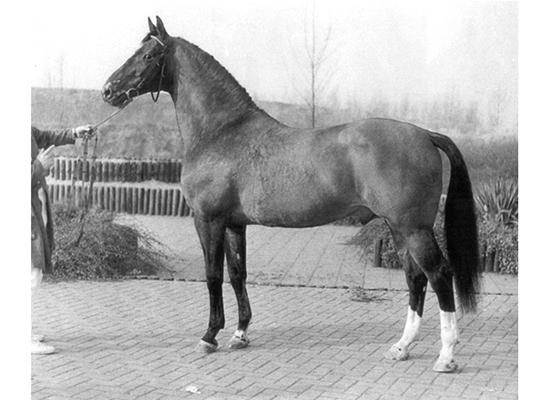
Amor (photo – Jacob Melissen
In 1961, one of the stars of the Holsteiner licensing was the Trakehner / Holstein cross, Heros who was granted a reserve premium. The young stallion was by the Swedish stallion Herrscher who was by the Trakehner, Heristal, but his dam, Barba, was all Holsteiner, by Loretto out of a Heinitz mare.
The Dutch Inspector Wiersema saw the stallion at the licensing and on returning home described the wonderful movement of Heros in an article, accompanied by a photo. A group of Dutch private stallion owners put together a consortium to buy the horse, for 9000 marks, and they took him home where he was re-named Amor.
In the following years, the Holsteiner Breeding Director discarded all the Herrscher offspring, because of their difficult temperaments…
Jacob Melissen in the 1992/93 edition of his The Leading Stallions of the Netherlands, has this to say about Amor:
“The stallion came to the Netherlands at the time that the breeding of riding horses had just about begun to develop and he was still there when Dutch sporthorses had become famous all over the world. Amor’s qualities were such that he not only had a modernising effect when the emphasis in the Netherlands was still on the agricultural side of breeding, but his valuable characteristics also proved useful when the trend had swayed towards the production of sport horses.”
“And yet Amor has not become famous for producing top-class sporthorses himself. Amor passed on the kind of qualities that are essential for sporthorses: movement, eagerness, temperament, sound bones, well-shaped neck, etc. Amor offspring do not have the old-fashioned muscular front but carry their weight on the rear, propelling, as it were, their powerful personality. That is exactly how you recognise his descendants, particularly when they are the typical light bays with dark manes, tail and lower legs. And they’ve sure got a mind of their own, these Amors. No doubt, that’s why there are not many of them who met the kind of rider to bring out their great qualities at top level.”
Even today, Dutch trainer and breeding authority, Johan Hamminga, is keenly aware of the qualities Amor continues to provide.
“Amor was a very nice stallion with a long neck, for that time, he was so modern – even today when you see in the dam line, Amor, it is much valued. They are very sound. Amor was a difficult horse, like Jazz now, but when you trust the horse, and the horse trusts you, it’s okay. The Amors were so hard, so good in the constitution, so good in the legs – never lame, never. They have a high tolerance of pain… he was a very important stallion for us.”
Jazz is the product of the breeding program of Huub and Tiny van Helvoirt, a program that began with mares by Amor.
Mr van Helvoirt explained to Karin de Haan for her article, Endy – the mare makes the difference (iDs/6):
“At the time we were looking for good Amor foals that we could use in our breeding business. We were pretty big fans of Amor because many of his offspring are good movers, which is why they often finished first at the selections. We’ve always considered movement very important in our breeding program.”
“The Amor foals were up north, so that’s where we went. The first foal we looked at that day was Warmante, Jazz’s grand dam. Initially we dismissed her because we were concerned that she wouldn’t grow big enough: Amor could sire a small foal now and then. We’ve always considered sufficient size important. We looked at more foals at several locations that day, and our last stop was Mr Lucassen’s place in Wehl. That’s where we found Wendy. We liked her and bought her immediately. On our way home, we started talking about Warmante again, the first foal we saw. We then decided to buy her too so that the two foals could grow up together.”
Between them the two mares would be responsible for the KWPN stallions, Zudenwind, Zhivago, Viento Uno W and Jazz – and they need not have worried about Warmante’s height: “Interestingly enough, Warmante and Wendy ultimately ended up the same height,” Mr van Helvoirt recalls. “So you see, you can’t predict exactly how a foal will turn out. Wendy grew to 16 hands, which is actually a bit smaller than we have expected. As far as the stallions we choose for our mares, we always look for those that pass on size to their offspring.”
But when Gemma examined the bloodlines to the third generation and contrasted it to the six generation analysis, she found that it was the modern dressage stallions that were influential…
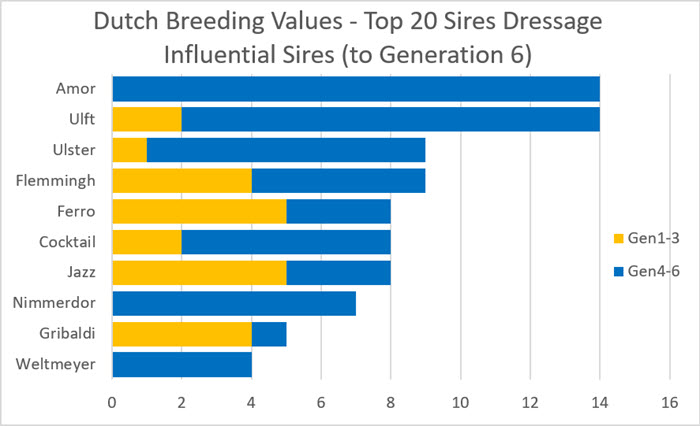
Postscript:
Hot on the heels of the release of the new KWPN breeding values comes the figures for numbers of mares covered in the KWPN book. This time it is a solidly Dutch bred stallion that attracted the largest book in 2019 – Kjento (Negro / Jazz) who sired 303 foals in the 2020 crop.
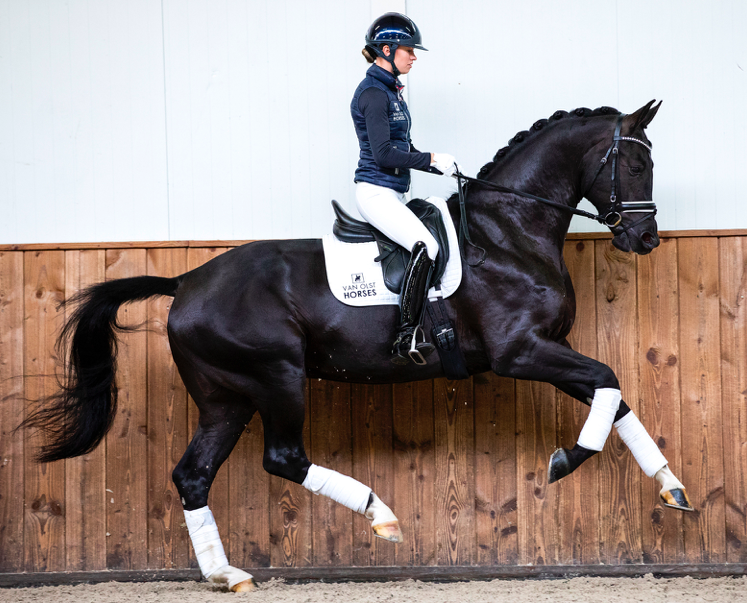
Kjento (photo – Equigeniek)
The second highest producer was again Dutch bred, Le Formidable (Bordeaux / Ferro), the licensing champion in 2019, he sired 278.
The third most popular is another licensing champion, this time from 2017, Jameson (Zack / Negro) who was a firm favorite with the spectators at the 2019 World Young Horse championships. He sired 235 foals in 2020.
Number four was Glamourdale (Lord Leatherdale / Negro) with 157 foals.
Rounding out the top five is Just Wimphof (De Niro / Riccione) who topped the table of popular stallions in 2018 and 2019. He was the sire of 150 foals.
It would appear that the mare owners continue to cheerfully ignore the breeding values when it comes to choosing a stallion – NOT ONE of the top twenty dressage stallions with a reliability of 90% or higher, made it to the popularity poll.
The stallions that were popular feature on the highly speculative values of ‘stallions with an expected breeding value based on lineage and their own performances’. This table is headed by Just Wimphof with a dressage value of 173 (excellent OCD rating, 107), followed by Iconic B (Bon Bravour / Jazz) 171, 99; Mister Maserati (Glocks Toto Jr / Jazz); Jameson, 167, 101 and fifth to Johnny Cash (Bon Bravour / Flemmingh) 165, 99.
To find the most popular stallion we have to go to 14th since Kjento has a breeding value of 161 and an OCD rating of 98. Le Formidable is ranked ninth, 162, 98 OCD score.
We find Glamourdale in the group of stallions ‘with 10 or more offspring in the sport and a reliability between 80% and 89%’ but he has the 17th highest dressage breeding value of 129 to go with an OCD score of 101.
Once again the trend towards the rich getting richer and the poor poorer continues. Of the 10,500 KWPN foals born in 2020, 4,800 were dressage bred. The five most used stallions accounted for 1123 foals or 23% of the total – an increase of 3%.
Here is a breakdown of the 2019 KWPN registered foals by 347 stallions.
* 263 stallions sired between 1 – 10 foals
* 38 stallions sired 11 – 25 foals
* 26 stallions sired 26 – 50 foals
* 11 stallions sired 51 – 100 foals
* 9 stallions sired 101 foals or more
The group of nine who produced more than 100 foals were responsible for 1628 foals out of the total of approximately 4,800.
The Jumpers
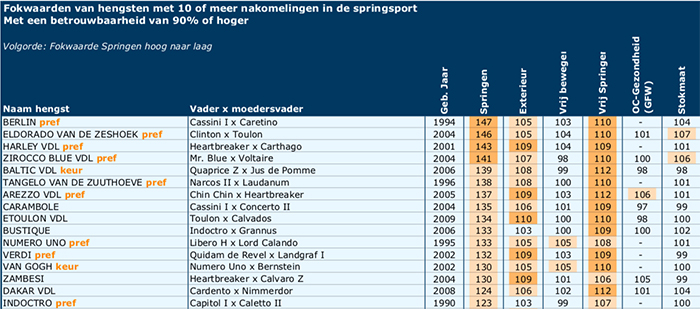
While we have seen the same half dozen names appear repeatedly in the first three generations of the dressage stallions, the breeding of the top 20 Jumping Stallions with a reliability of 90% is much more diverse.
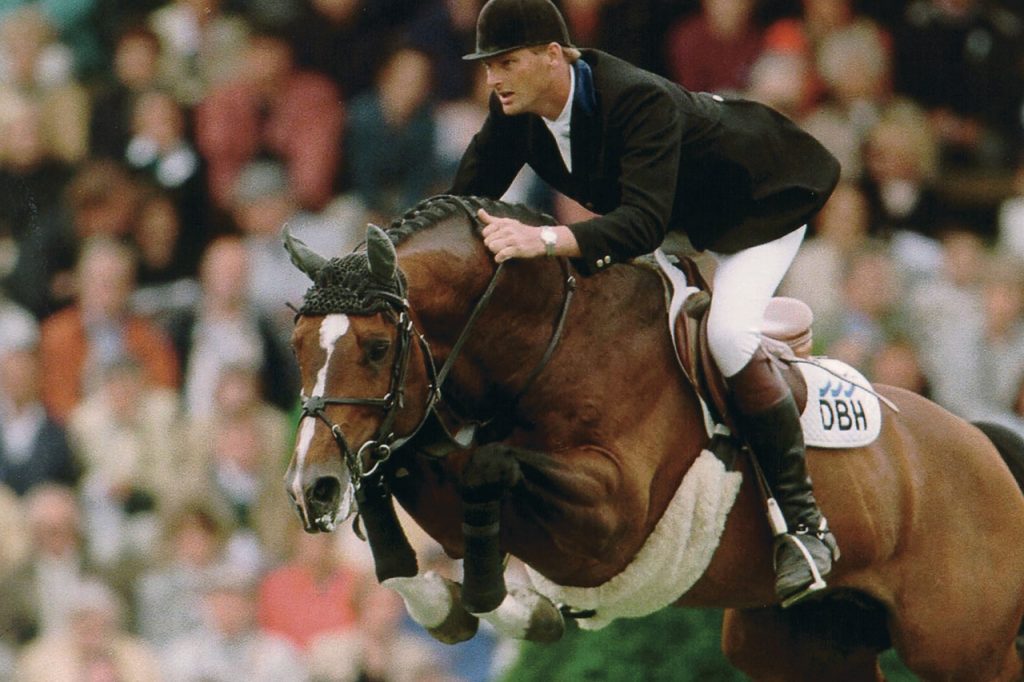
Heartbreaker – the most influential
Looking at the first two generations of the top 21 jumpers, Heartbreaker appears four times, Cassini I appears twice, Chin Chin, Numero Uno twice… that’s it. Numero Uno and Indoctro, both make the twenty, and are found in the breeding of stallions in the twenty. But what about if we track the blood back a little further, will we find a greater concentration?
Going back four or five (even six!) generations it is no surprise to find that Cor de la Bryère is the most influential stallion, appearing eleven times on the pedigrees of the 20. The distinguished Dutch breeder, Jan Greve, divided the great Holstein ‘C’s into C for clever in the case of Cor de la Bryère, and C for dumb power in the case of that other half of the equation, Capitol – and we find Capitol seven times.
Another historic figure in the development of the modern jumper, Landgraf occurs seven times, twice through his influential son Burggraaf who brought Landgraf’s blood to Holland. And Lord, another of the Holstein founding fathers, appears five times.
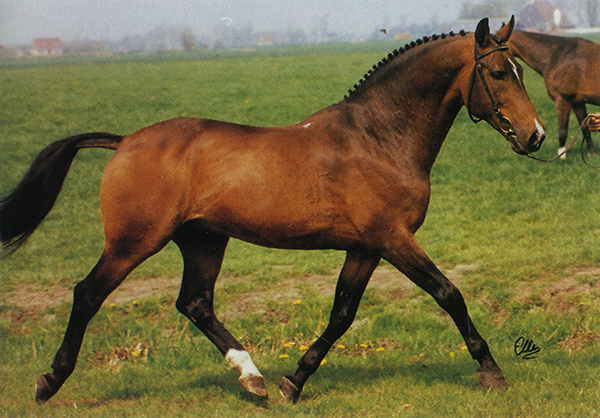
Nimmerdor
Another gift from Holstein to Holland, Nimmerdor appears seven times, while his son, Heartbreaker registers six times.
Ramiro who was heavily promoted and attracted huge numbers of mares, appears five times, and only on the dam line, and I am reminded of the point that has been made by my colleague, Judy Wardrope about Secretariat, who produced no runners of note, but excellent broodmares – even given the top mares that went to Secretariat it was inevitable that he would be a broodmare sire…

Berlin
Berlin heads the list. He was bred in Germany, the product of the breeding program of the famous jumping family – Pollman-Schweckhurst. It was Elmar Pollman-Schweckhurst who decided to cover Estia (competition name Cathleen) with Cassini I:
Elmar told Adriana van Tilburg: “I stood up for the decision of using Cassini I for Cathleen. This stallion impressed me as a young horse with his scope and perfect manners. At that time Cassini I was only five years old. I thought Cathleen could be the ideal mare for him to handle his weaknesses. Cathleen had blood, was careful, had hardness, an alert mind and a good topline and knee. On top of that I thought it would be interesting to double up the blood of Caletto II who died too early. The future would show that making the cross of Capitol I and Caletto II would become a perfect match.”
Indeed the Caletto II cross is the very model of line breeding, occurring on the dam line of Cassini, and the top line of Estia.
Berlin was sold to The Netherlands as a six-year-old and has been gratefully absorbed into the breeding program of the KWPN. He heads the latest values with a score of 147.
story continues below the advertisement
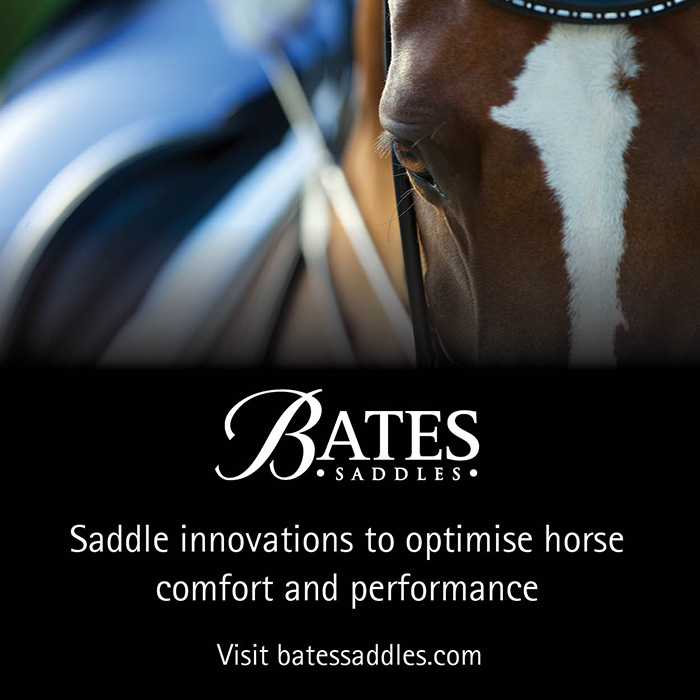
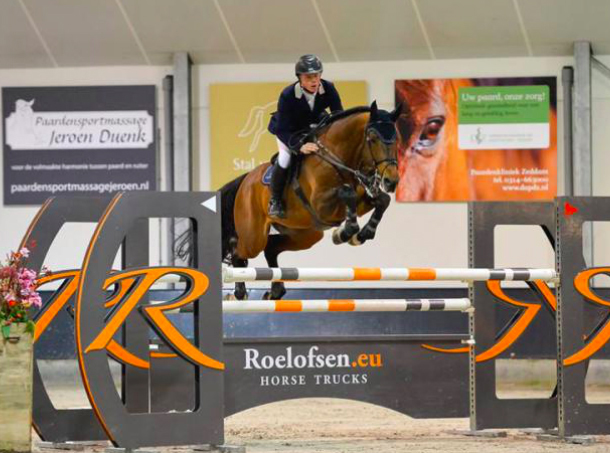 Eldorado
Eldorado
In second we have the Belgian product – Eldorado van de Zeshoek. He is by Clinton (Corrado / Masetto) the Holsteiner stallion who became a BWP Ambassadeur, out of Bijou Ora, third generation BWP, by the Heartbreaker son, Toulon, who was also proclaimed a BWP Ambassadeur.
Jan Greve was for a long time the Dutch team vet, but he is also one of the most successful sporthorse breeders in the world. His stud, De Watermolen has been home to a succession of jumping stallions, the most famous of which was Voltaire, but he has had many more, and continues to produce exceptional jumpers.
At the beginning of 2015, Jan’s son, Willem Greve took over the reins of Eldorado van de Zeshoek and immediately won the Grand Prix of Roosendaal. According to Willem: “Eldorado van de Zeshoek has unlimited scope and with his power he can jump all the classes in the world. Thereby he is competitive, so I’m very happy to have him in my stable!”
What does Jan Greve think of the horse as a sire?
“Eldorado is a very strong horse, very scopey, he needs a blood mare and he can give her the scope. She gives the brains, and he the scope. I must say he breeds well, we saw him in the sport, but now in the breeding, he is breeding very well. The main quality of his progeny is the scope, there is no fence too big or too high – if the mother gives a little bit of quality, then it is perfect. He fits very well with blood horses…”
Eldorado has a jumping breeding value of 146, and an OCD rating of 101.
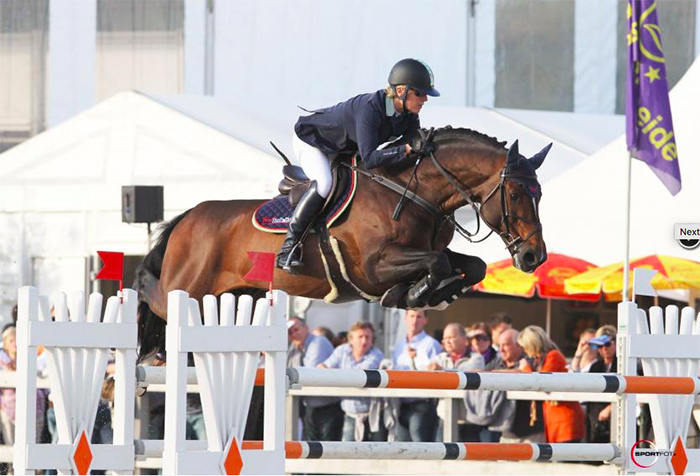
Harley
It is some measure of the dominance of the VDL stud in Dutch jumping breeding, that the next three stallions on the list Harley VDL (Heartbreaker / Carthago) jumping value 143, Zirocco Blue VDL (Mr Blue / Voltaire) 141, and an OCD rating of 100, Baltic VDL (Quaprice Z / Jus de Pomme) 139, 98 – are all from that stud, along with the 7th ranked Arezzo VDL (Chin Chin / Heartbreaker) 137, 106, 9th, Etoulon VDL (Toulon / Calvados) 134, 98, 15th Dakar VDL (Cardento / Nimmerdor) 124, 101, and rounding out the 20, Zapatero VDL (Chin Chin / Ircolando) 111, 104.
Others in the twenty one are the sixth ranked, French bred Tangelo van de Zuuthoeve (Narco II / Laudanum xx) currently flavour of the month thanks to his son, Tobago Z (Mr Blue), a recent Grand Prix winner at Wellington with Daniel Deusser.
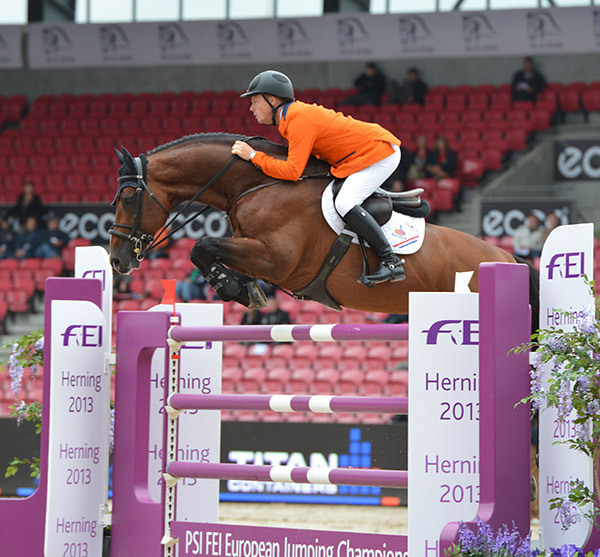
Carambole
Another of Willem Greve’s rides, Carambole (Cassini I / Concerto II) ranks eighth. Willem Greve rode Carambole throughout his career, starting in Young Horse classes in 2010. In 2013, the pair was part of the winning Nations Cup team at Copenhagen, and represented Holland at the European Championships. Carambole celebrated the 2015 season in great style, winning back-to-back Grand Prix in Drachten and Amsterdam… The pair had a solid start to 2016, with two placings a Braunschweig, 2nd in the Grand Prix and 3rd in the 1.50, before going on to place third in the five-star Grand Prix at s’Hertogenbosch in an absolutely top class field. Last year the pair were fourth in a Grand Prix at Valkenswaard.
Once again, let Jan Greve give us the inside running with a wonderful story that sees dressage breeder supremo, Burkhard Wahler (think De Niro) in the saddle and over a fence:
“A friend, Gerardus Post who is a stallion owner in the north at the Ritta Hoeve, called me up and said, ‘I’ve seen in the 30 day test a nice horse by Coriano, we should go and look.’ We went on the Sunday morning and I didn’t like the horse… end of story. Do you have another one? Yeah I might have, it is with Burkhard Wahler, at his station to freeze semen. We called, yeah, you can come. It was a little bit of a round tour but okay still in northern Germany.”
“We went, and the horse stood there, normal good shape. Can I see him ridden? ‘There is no-one here’, says Burkhard, ‘so I have to do it, but I haven’t been jumping for the last eight years, but I do it for you.’ So he put the saddle on, dressage saddle, made the stirrups a bit shorter, and jumped a cross pole, trotted up and the horse jumped fantastic. He jumped the cross pole in the same way he now jumps 1.60m. Then we made a vertical, maybe the biggest one was three feet, and a little square oxer, and always with style, and always quick. Okay that’s enough. Then we bought two thirds of him in the car on the way home. That’s how we found Carambole.”
As a breeding stallion, what do you think he brings to his progeny?
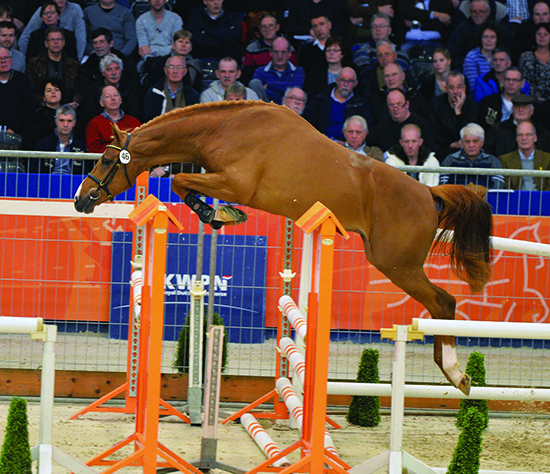
By Carambole out of a Stakkato mare
“He gives a very good brain, very quick, the reflexes on him are quick from the ground, which I think is the important thing for a good showjumper. He jumps very quickly from the ground, you can hardly see how he comes up. When you go in the jump off, you never have to think of the first pole, if the rider has to think of the first pole, he’s lost already. They like to jump, they are rideable, like himself.”
Are there any particular mares he works best with?
“I think he should have a little bit of blood in the mother line, otherwise sometimes the Contender comes back and you get a bit of an old fashioned type, but even if you have an old fashioned type by him, they are quick in the body, modern in the mind, they are not slow thinkers. Intelligent – that’s important, to be athletic and intelligent, that’s what it is all about.”
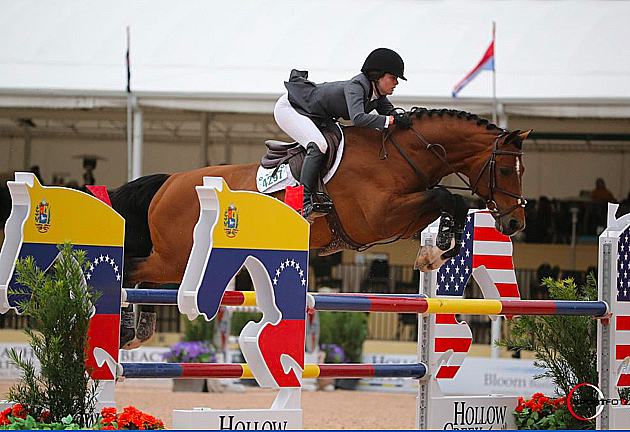
Bustique (photo – Rebecca Walton/Phelps Media Group)
Not only is Indoctro in 16th place on the breeding values, but his son Bustique (Grannus) is ranked 10th, 133 Breeding Value, 100 OCD. Bustique was one that almost got away, as long time jumping stallion assessor, Cor Loeffen told me:
“Bustique was a very nice horse and the breeders used him one or two years, he was jumping 1.35, 1.40, but we did not use him. Hendrix sold him to the United States and now his products are eight or nine years old and they jump very well. The stallion has come back to Holland and now the breeders can use him. That’s a good moment.”
story continues below the advertisement
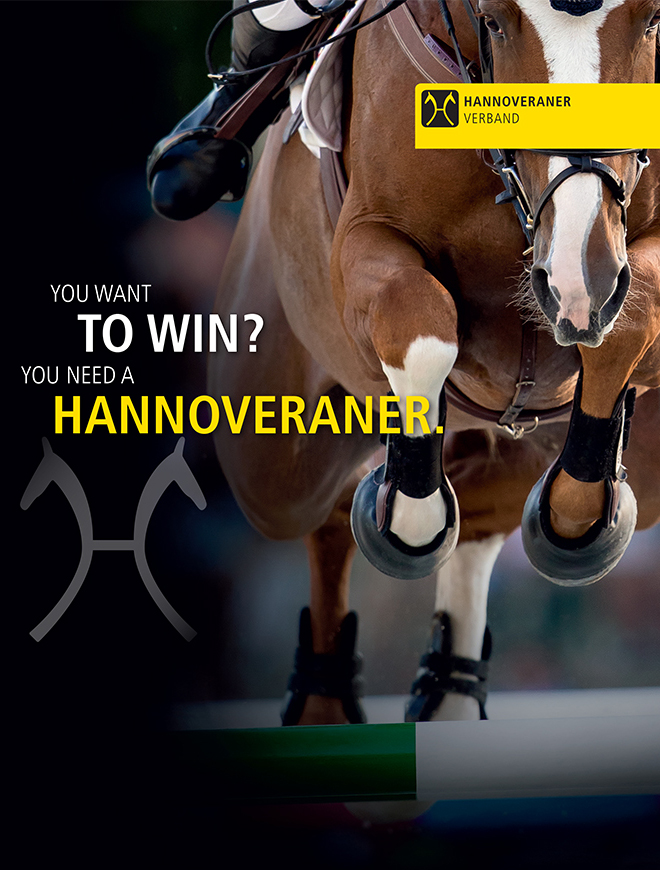
Numero Uno (Libero H / Lord Calando) ranks 11th with a value of 133, while his son Van Gogh (Bernstein) is 13th, 130. Van Gogh is famously the sire of dressage gold medallist, Cosmo, but he was himself a true superstar with Marco Kutscher, winning the Grand Prix of Valkenswaard 2015, the Longines GP in Los Angeles 2015, and the Hong Kong Grand Prix in 2016, for winnings of over one million euros. Shortly after his Hong Kong win, Van Gogh suffered a crushing fall in Rome, and although he returned to jump smaller classes, he never regained his true form.
Verdi competing at the London Olympics
Others to make the top 21: 12th, Verdi (Quidam de Revel / Landgraf) 132; Zambesi (Heartbreaker / Calvaro) 130, 105; 14th, Sam R (Mermus R / Abgar xx) 121; 18th, Unaniem (Numero Uno / Voltaire) 117, 18th, Up To Date (Camerino / Colino) 115 and Quasimodo vd Molendref (Heartbreaker / Lys de Darmen) 114, 99.
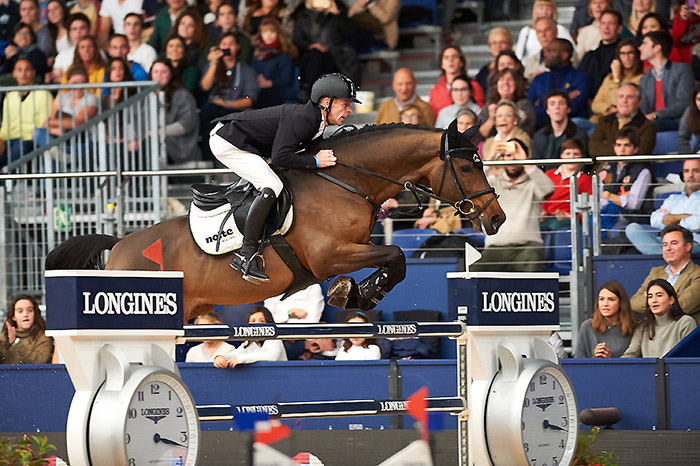
Comme il Faut
The highest breeding value for the foreign stallions of 163 (OCD 101) belongs to the royally bred Comme il Faut (by Cornet Obolensky out of Ratina Z) just in front of another representative of the BWP, Emerald van ‘t Ruytershof (Diamant de Sémilly / Carthago) 162 (91!). They are followed by yet another BWP Ambassadeur, Halifax van het Kluizebos (Heartbreaker / Fetiche du Pas), an international competitor with Lorenzo de Luca. 155 (101).
Cornet Obolensky over the water at the Euros in Rotterdam
Fourth spot to the great Cornet Obolensky (Clinton / Heartbreaker) 154 and 99. Fifth to Casallo Z (Casall / Carthago) 150, 100.
Seventh to the French star, Qlassic Bois Margot (L’Arc de Triomphe / Galoubet A) 148, 102. Eighth one I’ve never heard of, Aristoteles V (Padinus / Lux) who competes in the United States with Jonothan McCrea. Their fifteen minutes of fame came at Saugerties in 2018 where they won a 5* GP table A, since then the results have been modest.
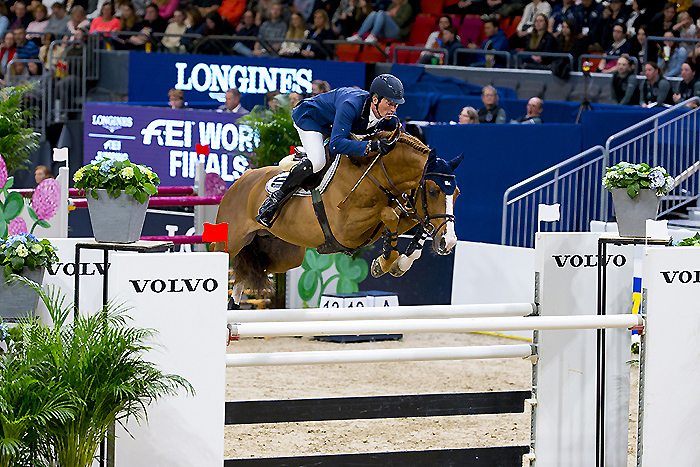
Tobago Z
Ninth to one of the genuine stars of the moment, Tobago Z (Tangelo van de Zuuthoeve / Mr Blue) 146, 98. Rounding out the ten, another comparative unknown, Hardrock Z (Heartbreaker / Carthago) who competes with the Venezuelan rider, Emanuel Andrea. 145, 99.
Let’s see what Gemma has discovered…
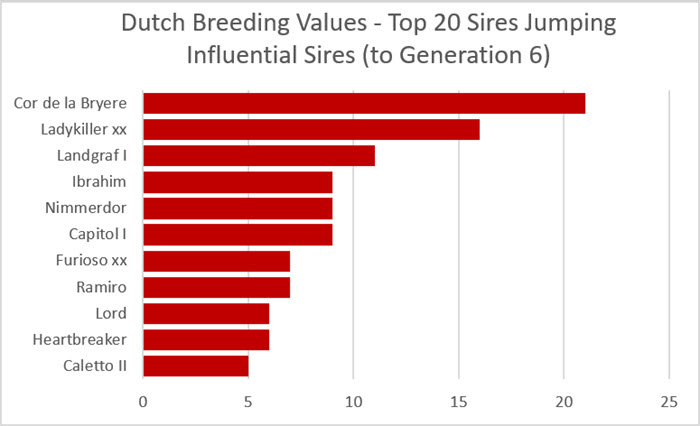
It’s absolutely no surprise that all of the top 20 Dutch jumping stallions (reliability >90%) have at least one of the ‘most influential’ sires appearing in the first six generations of their pedigrees. The ‘loosest’ bred of these top 20 is Tangelo van de Zuuthoeve (Narcos II /Laudanum xx), the most influential sire making an appearance is Ibrahim (The Last Orange / Porte Bonhuer), who appears three times in the first six generations.
The most influential of the influential sires of these Dutch jumpers was that absolute stalwart of jumping breeding, Cor de la Bryère (Rantzau xx/Lurioso), who appears in the first six generations of these stallions a massive 21 times. Next is the great Thoroughbred Ladykiller xx (Sailing Light xx/ Loaningdale xx), making 16 appearances. Rounding out the top three influences, we have the Ladykiller xx son, Landgraf I (Ladykiller xx /Aldato), being found 11 times in the first six generations.
Again when Gemma looked at the third generation, then a more diverse crew of stallions came to the fore:
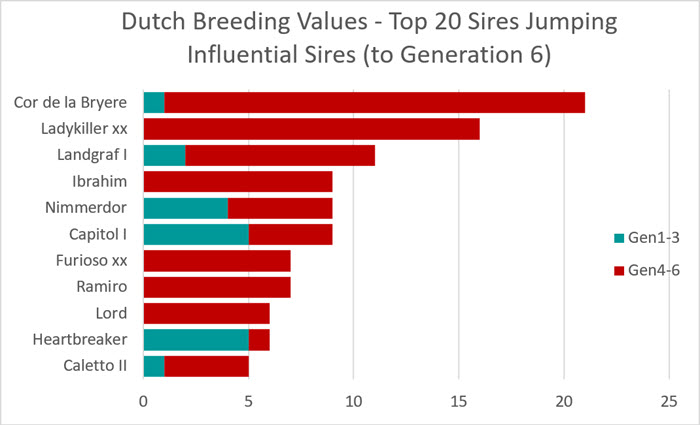
It is one of the fascinating aspects of the transformation of the modern Warmblood that has occurred in the past twenty years, that while so much has changed, the blood of those original and founding stallions continues to flow through the veins of today’s stars.
Postscript – Jumping Stallions
There is somewhat more correlation between the jumping breeding values, and the number of mares covered, than with the dressage breeders – and the jumping breeders used a far wider selection of sires.
The most used jumping stallion in 2019, was Grandorado TN (Eldorado van Zeshoek / Carolus II) with 215 foals in 2020.
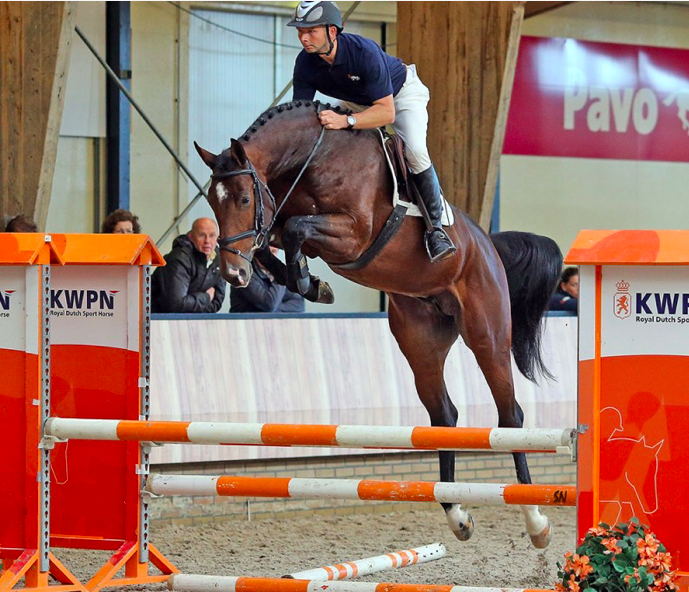
Grandorado TN (photo Team Nijhof)
Grandorado is by Eldorado van Zeshoek, out of a mare by the Capitol son, Carolus II, out of a mare by Baloubet de Rouet. He has been a moderate performer with Willem Greve for winnings of €34,547 – his most recent outing, the ill-fated Spanish series at Vejer de la Frontera, saw his best result a 12th in a GP class.
Next, Hardrock Z (Heartbreaker / Carthago) with 159. Hardrock is by the great Heartbreaker out of a mare by Carthago (Capitol / Calando I), out of a mare by Ratina’s full-brother Rebel IZ (Ramiro / Almé).
Hardrock has been a respectable jumper with Venezuela’s Emanuel Andrade with winnings of €131,793. Their most recent placing was a 5th in a 5* Grand Prix at Saugerties in October 2018.
Tangelo van Zuuthoeve (Narcos II / Laudanum xx) is next with 133 foals. Tangelo was an international Grand Prix placegetter with Roelof Brils. His most successful offspring, with winnings of €233,602 is Tobago Z. The chestnut stallion is 25 years old and continues to attract mares to prove that jumping breeders are less influenced by the vagaries of fashion than their dressage counterparts.
Poker de Mariposa drops from number one last year to fourth with 127 – this is the only stallion in the top 5 not recognized or approved by the KWPN, which says heaps about the trend for modern breeders to cheerfully ignore studbook loyalty and breed where they like.
Poker was bred by Koen de Brabander, the son of the late Herman de Brabander (a cousin of Joris) who founded the Mariposa stud. In an interview with Horse Telex, Koen paid tribute to his father’s influence:
“My father laid the fundament of our breeding, he enabled me to start with a good dam line. That’s half of the job, the other half is the selection of the sires. In the past my father paid quite some attention to the conformation, I’m not very strict on that. Taking Flora de Mariposa as an example, my criteria are: a modern conformation, lots of blood and good mechanics. By aiming for these demands I’m satisfied about my breeding products.”
“In the past I purely concentrated on sport stallions doing great in top sport. Today I equally select for a super dam line, as this also gives reliability to breeding.”
Flora at the Europeans in Aachen
Sure enough on Poker’s pedigree, on the mare line we see jumpers in each of the four generations. Poker’s dam Ilena jumped 1.55, while grand dam, Flora was an international star with Penelope Leprevost.
Cardento, proving himself with Peter Erikssen
Rounding out the five we have Carrera VDL with 124 foals. Carrera is by Cardento (Capitol / Lord), another ‘failure’ at the licensing, but VDL stud principal, Weipke van der Lageweg, had faith in the great stallion and sent him to Sweden where he was a star with Peter Erikssen before his triumphal return to Holland and the welcoming arms of the KWPN.
Carrera is out of Vantiels Esprit (Baloubet de Rouet / Zeus), while the second dam, Espri (by the Selle Français Zeus out of a mare by the Trakehner, Orlof) was the dam of Tinka’s Boy, a megastar with Markus Fuchs.
So in the ranks of the five most popular jumping stallions we have only two of the leaders on the breeding values rankings – Eldorado (2nd) and Tangelo (6th). We find two more in the ranks of stallions that are recognized but not approved – Tobago Z (9th) and Hardrock Z (10th).
The five most popular stallions accounted for 758 foals, more than 15% of the total – up 2% on last year. 501 stallions sired foals, of these 390 produced between 1 and 10, 60 produced 11 to 25, 31 produced 26 – 50, 14 produced 51 – 100, and 6 produced 100 or more. The stallions in the 1 to 10 group were the most numerous, 1,100. Compared to the dressage breeders, the jumping breeders used many more stallions to produce their foals.
ends
Want to breed a dressage or jumping star? There is a wonderful selection of top European stallions available via frozen semen at International Horse Breeders…
Toto Junior

